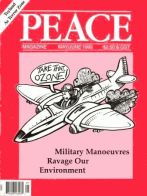
Peace Magazine May-Jun 1992, page 28. Some rights reserved.
Search for other articles by Mark Leith here
Seymour Hersh (author); Random House, 1991. 354 pages, $23.00
PUT succinctly, the Samson Option describes Israel's development, since its inception, of a clandestine nuclear weapons program. It argues that the U.S. government has been aware of this program and that Israel has considered using its nuclear weapons both during the 1973 Yom Kippur War and in the recent Gulf War.
The author, Seymour Hersh, is the New York Times journalist who broke the story on the My Lai massacre in South Vietnam. Mr. Hersh follows the Israeli nuclear program through successive Israeli and U.S. administrations, starting with Ben-Gurion and Eisenhower. In the style of investigative journalism, he leads us through numerous interviews with many of the leading players, particularly in the intelligence communities.
Hersh theorizes that in response to the Nazi holocaust, Ben-Gurion sought the Samson option, taking its name from the biblical Samson who in pulling down the pillars around him destroyed his enemies with himself.
A great deal of Israel's nuclear expertise came from the French. The Israelis were later to collaborate with South Africa in the '70s, including a joint nuclear test. The work has been taking place in an underground facility in the Negev desert, disguised as a nuclear reactor. It was unveiled by now imprisoned technician Mordecai Vanunu. It is the same story that came to light in Iraq since the Gulf War.
Hersh offers two explanations for the Americans' failure to blow the whistle, depending on which party was in power. The Democrats, he says, feared the Jewish lobby, while the Republicans simply had no trouble with the idea of proliferation.
During the Yom Kippur War, Kissinger was informed of the Israelis' intention to use nuclear weapons if a resupply of arms from the U.S. was not forthcoming. During the Gulf War an American satellite picked up deployed nuclear weapons on mobile launchers facing Iraq as part of a full-scale Israeli nuclear alert.
The author's conclusion is that if and when there is another war in the Middle East, it will most probably escalate to a nuclear one.
What should be the conclusion for the Canadian peace movement? An important goal and the stated goal of our government is universal adherence to the Non-Proliferation Treaty by 1995. Israel is not the only undeclared nuclear country which has not signed the Non-Proliferation Treaty. India and Pakistan, also with sizeable expatriate communities in Canada, are felt to be in the same category. It is incumbent upon us as Canadians, particularly those who are members of Jewish, Indian and Pakistani communities, to raise our voices within these communities.We must work against nuclear proliferation; it is urgent for these respective governments to join the non-proliferation regime and strengthen it with a comprehensive ban on nuclear testing.
We owe it to our children to draw from the holocaust the lessons of Moses, who was the deliyerer of laws, rather than Samson, the destroyer.
Mark Leith is the past president of the Toronto chapier of Canadian Physicians for the Prevention of Nuclear War.

Peace Magazine May-Jun 1992, page 28. Some rights reserved.
Search for other articles by Mark Leith here